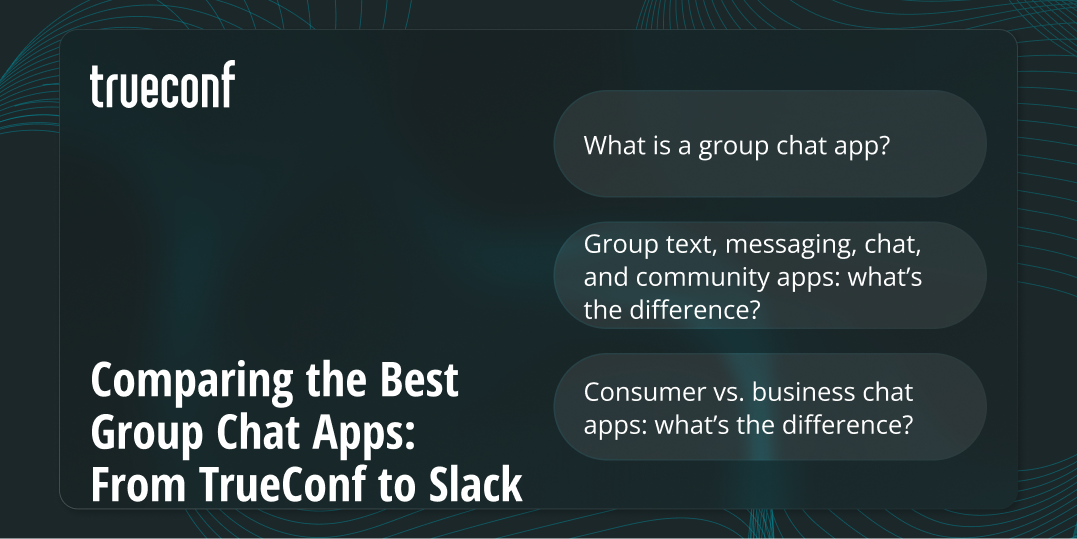Comparing the Best Group Chat Apps: From TrueConf to Slack

What is a Group Chat App?
A group chat platform represents an online collaboration environment that allows numerous individuals to share information and work together instantly within designated digital spaces, often known as channels, rooms, or discussion groups. Unlike traditional text-based applications that prioritize direct one-on-one exchanges, modern group chat systems are crafted for ongoing, organized, and collective communication, enabling both informal dialogues and structured team interaction.
These platforms establish a unified communication center where users can deliver messages, distribute documents, exchange visuals, and coordinate efforts across any device — be it computer, smartphone, or tablet. They assist teams in maintaining efficiency by consolidating conversations, resources, and notifications in a single location, minimizing reliance on long email chains or disconnected tools spread over multiple systems.
Group Text, Messaging, Chat, and Community Apps: What’s the Difference?
Before examining particular platforms, it becomes essential to recognize how various classifications of communication applications differ from one another. Although Group Text, Messaging, Chat, and Community apps might seem alike initially, each category fulfills unique objectives, targets specific audiences, and supports distinct interaction frameworks.
The comparative table presented below outlines the fundamental variations in purpose, usability, and structural design that distinguish every type of modern group communication solution:
|
Feature/type |
Group Text Platforms |
Group Messaging Solutions |
Group Chat Systems |
Community Discussion Platforms |
|---|---|---|---|---|
|
Connection type |
Cellular network (SMS/MMS) |
Internet-based (Wi-Fi or mobile service) |
Internet (cloud-hosted or on-premise) |
Internet (distributed community platforms) |
|
Main purpose |
Basic message exchange |
Daily conversational interaction |
Team cooperation and efficiency |
Wide-scale community or interest-driven engagement |
|
Group size |
Small (2–25 participants) |
Compact to moderate (around 100 members) |
Medium-sized (departments, workgroups) |
Extensive (hundreds or even thousands) |
|
Features |
Text communication, limited attachments |
File exchange, voice calls, encryption support |
Channels, document sharing, automation, security policies |
Open discussions, moderation dashboards, roles, participation guidelines |
|
Security level |
Low (network-dependent) |
Moderate to strong (end-to-end protection) |
High (enterprise-level, admin privileges) |
Medium (emphasis on transparency) |
|
Persistence |
Short-term or restricted |
Saved message records |
Searchable and continuous history |
Permanent, open or semi-public spaces |
|
Integration options |
None available |
Basic (contacts, call sync) |
Advanced (project management, scheduling, CRM links) |
Selective (bots, social extensions) |
|
Typical users |
Close friends, relatives |
Interest groups, small teams |
Businesses, enterprises |
Online networks, fandoms, educational hubs |
|
Examples |
iMessage, Google Messages |
WhatsApp, Telegram, Signal |
TrueConf, Slack, Microsoft Teams |
Discord, Reddit Chat, Telegram Groups |
Choosing the Right Type of Group Communication App for Your Needs
Various communication scenarios demand specialized solutions. Whether the goal involves brief message sharing, routine group coordination, workplace cooperation, or overseeing an extensive online network — every type of messaging platform delivers distinct advantages and functionalities designed to meet diverse requirements:
- For primary communication
- For frequent group discussions
- For professional teamwork and efficiency
- For broad communities and engagement
Select Group Text Applications when stable, SMS-based messaging becomes essential, and internet connectivity is limited or absent. These tools are ideal for short notifications, emergency alerts, or keeping communication active during service disruptions. They focus on simplicity and consistency, ensuring reliable message delivery with minimal setup and only fundamental functionality.
Implement Group Messaging Platforms like WhatsApp or Telegram to support flexible, media-rich communication experiences. These platforms rely on the internet, enabling users to send texts, share pictures, videos, or audio messages, and conduct encrypted calls in real time. Integrated end-to-end encryption maintains privacy, while additions such as group organization, reactions, and cloud-based storage enhance usability for everyday exchanges among families, friends, or compact teams.
Opt for Group Chat Applications such as TrueConf, Slack, or Microsoft Teams to encourage structured, business-level cooperation. These systems are optimized for task-oriented communication, featuring topic-based channels, secure data synchronization, and integration with external ecosystems like CRMs, scheduling tools, and workflow managers. With features such as file sharing, conversation indexing, advanced search, and administrative control, they represent the core infrastructure of collaborative digital environments.
Employ Community Messaging Platforms including Discord or Reddit Chat to establish, organize, and guide large-scale audiences connected by shared passions. These frameworks provide open or moderated spaces that let users join themed discussions, take part in virtual events, and exchange messages instantaneously. Using role assignment, moderation panels, and participation guidelines, they maintain balanced communication within networks hosting thousands of members.
Together, these classifications demonstrate how messaging ecosystems have expanded — transforming from minimal text tools into robust, integrated systems that drive collaboration, creativity, and social connectivity on a global scale.
Consumer vs. Business Chat Apps: What’s the Difference
Consumer chat applications are developed for casual and social interaction — allowing users to remain in touch with relatives, companions, or online groups. These systems emphasize simplicity, entertainment, and accessibility, including functions such as emojis, animated stickers, voice or video conversations, and shared chat rooms. Typically, they are free to use, user-friendly, and optimized for smartphones or tablets. Well-known examples include WhatsApp, Telegram, Facebook Messenger, and Google Chat, all of which make everyday communication seamless and enjoyable.
Business chat solutions, by contrast, are tailored for organizational collaboration. They enable staff to coordinate workflows, distribute files, conduct online conferences, and sustain structured communication within teams or entire enterprises. Security management, administrative control, and integration with productivity ecosystems represent the main priorities. Platforms such as TrueConf, Slack, Microsoft Teams, and Google Chat provide companies with the tools to maintain efficient internal communication while ensuring the protection of confidential data.
Empower your team’s group chats with TrueConf!
A powerful self-hosted video conferencing solution for up to 1,000 users, available on desktop, mobile, and room systems.
Comparison: Consumer vs. Business Chat Apps
|
Feature/aspect |
Consumer Messaging Platforms |
Business Collaboration Platforms |
|---|---|---|
|
Primary purpose |
Casual and social interaction |
Professional teamwork and corporate communication |
|
Typical users |
Individuals, friends, and families |
Enterprises, departments, and large organizations |
|
Main focus |
Simplicity, enjoyment, and connection |
Efficiency, coordination, and information security |
|
Communication style |
Relaxed, spontaneous, and informal |
Organized, structured, and objective-driven |
|
Key features |
Stickers, emojis, multimedia sharing, and real-time calls |
Channels, document exchange, task organization, and system integrations |
|
Security level |
Standard encryption ensuring confidentiality |
Advanced protection with admin management and private deployment options |
|
Integrations |
Minimal or basic connectivity |
Comprehensive integrations (CRM, project management, calendars, and storage) |
|
Examples |
WhatsApp, Telegram, Facebook Messenger, Google Chat |
TrueConf, Slack, Microsoft Teams, Google Chat |
Best Group Chat for Consumers
When discussing personal communication, consumer-oriented chat platforms emphasize efficiency, engagement, and accessibility. They are engineered to keep individuals connected with family, friends, and communities through appealing, intuitive interfaces.
The following examples represent some of the most widely adopted and feature-packed messaging applications globally:
Recognized as one of the most dominant communication platforms worldwide, WhatsApp combines usability with robust security. It provides end-to-end encryption, safeguarding every message, call, and file exchange. Users are able to create extensive group chats, instantly share photos, clips, voice recordings, or documents.
Additionally, WhatsApp supports cross-device synchronization, status updates, and high-quality calls, positioning it as a dependable tool for everyday digital interaction.
Facebook Messenger
Created by Meta, Messenger is tightly linked with Facebook, enabling seamless interaction with contacts, participation in group discussions, and access to video rooms. The platform features reactions, polls, games, and augmented reality filters, transforming ordinary conversations into interactive experiences.
It also allows encrypted exchanges and cross-platform use, balancing fun communication with essential privacy protection.
Telegram
Celebrated for its speed, versatility, and focus on privacy, Telegram operates as a cloud-driven service supporting massive groups and public channels with thousands of participants. It offers large file transfers, custom bots, and self-destructing secret chats for enhanced confidentiality.
Its multi-device synchronization, open-source API, and broad accessibility make Telegram especially popular among developers, influencers, and active online communities.
Viber
Viber emphasizes security and global reach. The platform delivers end-to-end encryption, HD-quality calls, sticker packs, and Viber Communities for large-scale discussions. It also enables low-cost international calling to external numbers, which appeals to travelers and global families.
Combined with an intuitive interface and strong performance on mobile networks, Viber offers smooth and secure communication across regions.
More than a simple messaging app, WeChat serves as a comprehensive digital ecosystem in China and abroad. It merges chatting, social networking, mobile payments, and mini-apps into one integrated service. Users can communicate, share daily moments, pay bills, book rides, and shop — all without leaving the platform.
Its group functionality includes media sharing, reactions, and integration with lifestyle services, solidifying WeChat as one of the most powerful multipurpose platforms globally.
Together, these consumer chat solutions redefine how people stay connected, from secure and private exchanges to immersive, socially integrated experiences, allowing seamless communication tailored to modern lifestyles.
Best Group Chat for Businesses and Organizations
In today’s digital workspace, smooth communication serves as the foundation of efficiency and team alignment. Enterprise-grade chat solutions move beyond ordinary messaging — they act as collaborative ecosystems that connect teams, simplify processes, and uphold data integrity across global operations.
Below is a selection of the most dynamic and reliable tools designed to optimize communication for organizations of every scale:
TrueConf
TrueConf represents a self-managed conferencing and messaging system built for organizations emphasizing confidentiality, governance, and control. Unlike traditional cloud-based services, TrueConf is deployed on-premise, granting companies full oversight of their communication framework.
It delivers group messaging, high-definition meetings, status indicators, document transfer, and Active Directory integration. With options for LAN or WAN configuration, TrueConf guarantees uninterrupted communication even offline — an ideal choice for corporate, governmental, or regulated sectors demanding compliance and reliability.
Slack
As a trailblazer in workplace collaboration, Slack reshapes digital communication into a unified operational center. Conversations are organized into thematic channels, allowing seamless file sharing and integration with thousands of external services, such as Google Drive, Trello, GitHub, and Zoom. Slack’s intelligent search, workflow automation, and custom bots minimize clutter and enhance teamwork.
Combining instant messaging, threaded discussions, and enterprise-grade security, Slack remains a preferred tool for startups, agencies, and multinational corporations alike.
Microsoft Teams
Microsoft Teams forms the core of Microsoft 365, delivering chat, calls, meetings, and collaboration features within one cohesive platform. Users can create departments and channels, co-edit content in Word, Excel, or PowerPoint, and synchronize work via SharePoint and OneDrive.
Teams includes advanced encryption, multi-factor login, and compliance dashboards, making it ideal for enterprises managing global operations and structured internal communication.
Google Chat
Integrated within Google Workspace, Google Chat offers a streamlined messaging environment that works in harmony with Gmail, Drive, Docs, and Meet. It enables direct messages, group threads, and file uploads, enhanced by Google AI-powered search. Thanks to its tight connection with Google Meet, text-based discussions can transition instantly into video calls.
With its clean design and familiar interface, Google Chat is best suited for teams already embedded in Google’s productivity suite.
MessageDesk
MessageDesk specializes in business-grade SMS management, delivering an organized way for teams to handle customer or staff conversations efficiently. It supports shared inboxes, automated replies, and mass messaging, making it invaluable for support departments, reminder notifications, and marketing outreach.
The platform seamlessly links internal communication with external engagement, ensuring organizations maintain fast, professional, and consistent contact with their audiences.
Spike
Spike revolutionizes email-based collaboration by merging inbox management with instant chat functionality. Its conversation-style design turns conventional email threads into real-time group discussions, eliminating unnecessary context shifts.
Features like voice notes, file previews, integrated tasks, and collaborative notes make Spike particularly effective for teams relying heavily on email but seeking a modern, chat-driven workflow.
Workplace from Meta
Built by Meta, Workplace translates the social networking experience into a secure, corporate-grade collaboration tool. It delivers group chats, live video streams, news feeds, and collaborative communities that mirror Facebook’s interface for easy adoption.
With seamless integration into Microsoft 365, Zoom, and Google Workspace, it enhances transparency and fosters company-wide engagement while maintaining robust enterprise security controls.
Collectively, these enterprise communication tools address a spectrum of professional needs, from on-premise security-driven infrastructures like TrueConf to scalable cloud ecosystems such as Slack and Microsoft Teams. Each solution strengthens collaboration, enabling organizations to communicate clearly, manage workflows, and achieve consistent productivity across any environment.
FAQ
What is the best free app for team communication, and how does TrueConf fit this category?
TrueConf is a strong option for free team communication because it provides messaging, file sharing, collaboration tools and video conferencing under its free Server Free plan for up to 1,000 users. It supports private and group chats, channels, file transfers and shared folders, allowing teams to collaborate continuously. TrueConf Server Free also includes video conferencing with no time limits on compatible infrastructure. The platform focuses on security with AES-256 encryption and on premises or hybrid deployment for full control of data. If your team needs a free communication tool that combines chat and meetings while maintaining privacy, TrueConf is a very strong choice.
Is TrueConf available as a free team chat solution?
Yes — TrueConf Server Free is a free team chat solution. It provides a secure team messenger with personal and group chats, file sharing, presence statuses and other collaboration features. The free version supports up to 1,000 users and is free for unlimited time even for commercial use.
What are the limitations of the free TrueConf plan compared to paid versions?
Here are some of the key limitations of the free TrueConf Server Free plan compared to the paid versions:
- While user registration is not limited on TrueConf Server Free, some higher-capacity features (such as large-scale conferences and full federation) are reserved for paid editions.
- The free plan supports only one external guest connection for public web conferences.
- Certain deployment modes (like completely offline activation without Internet connectivity) are available only in the full paid version.
- Interoperability with SIP/H.323/RTSP endpoints is limited under the free plan: for example, only 1 such connection is permitted.
- The full list of enterprise-grade capabilities (e.g., webinar registration, streaming to large audiences, federation with external TrueConf servers) is included only in paid versions.
How long can you use TrueConf for free messaging and video meetings?
The free plan does not expire and can be used indefinitely, making it a long-term option for teams that need reliable communication tools without additional costs. Once activated, it remains fully functional, and you can continue using messaging, group chats and video meetings as long as you renew the free license once per year. This annual renewal is quick and keeps your deployment active without requiring any payment.
Which is the best free chat app for business, and can TrueConf be used professionally?
Yes — when it comes to free chat apps for business, TrueConf Server Free is definitely professional-grade and suitable for serious team communication.
Here’s how TrueConf fits the bill:
- It provides corporate-messenger features, including personal and group chats, file sharing and collaboration tools, under a free plan for up to 1,000 users.
- The platform supports video conferencing, high-quality audio/video, and can be deployed on-premises (which many businesses prefer for privacy and control).
- TrueConf is positioned for businesses, including SMEs and enterprises, and offers upgrades when more advanced features are needed.
What is the downside of free team chat apps, and how does TrueConf address these issues?
Typical downsides of free chat apps for teams:
- They often limit key business features such as large group size, external guest access, advanced integrations or encryption.
- Time limits or usage-caps may apply (e.g., meetings cut off after a certain duration).
- Free versions may host data on third-party infrastructure or lack full control over deployment.
- Support and administrative/management tools tend to be restricted or minimal in free tiers.
- Integration with corporate systems (SSO, directory services) may be absent or limited.
How TrueConf addresses these issues:
- TrueConf’s Server Free version supports up to 1,000 users and offers team messenger + video conferencing features.
- It can be deployed on-premises (or in a private infrastructure) which gives organisations data control rather than relying solely on third-party cloud
- The free version carries no expiration date and can be used indefinitely (with annual licence renewal) for its free plan.
- It supports enterprise-grade features like integration with directory services, file sharing, group chats and video meetings, which makes it suitable for professional use rather than only casual messaging.
- While limitations still exist (e.g., certain advanced features are reserved for paid editions), the free plan bridges many of the typical free-tier downsides and offers a solid basis for team collaboration.
What app is everyone using to chat, and how does TrueConf compare among popular choices?
When people ask “What app is everyone using to chat?”, they’re often referring to very popular platforms like Microsoft Teams, Slack, Zoom or Google Chat — these have broad recognition and adoption in business and teams.
Here’s how TrueConf compares among those popular choices:
- TrueConf offers team messaging + personal/group chats + file sharing integrated with its video-conferencing & collaboration suite.
- It emphasises security, on-premises or private-cloud deployment, which many mainstream solutions do not offer in their free or low-cost tiers.
- Because TrueConf supports both chats and very large meetings (and claims things like “conference without time limits” in its free version) it positions itself as an all-in-one alternative rather than using separate apps for messaging and meetings.
About the Author
Nikita Dymenko is a technology writer and business development professional with more than six years of experience in the unified communications industry. Drawing on his background in product management, strategic growth, and business development at TrueConf, Nikita creates insightful articles and reviews about video conferencing platforms, collaboration tools, and enterprise messaging solutions.




Follow us on social networks